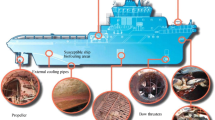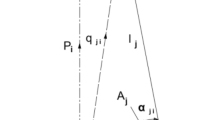Abstract
The authors have recently developed a 3D shape measurement method using a combination line charge-coupled device (CCD) camera that can accurately measure 3D shapes underwater. This method can precisely measure the deformation of flexible composite marine propellers. The authors measured the deformation of a flexible model propeller fabricated with a 3D printer. To utilize the results of the deformation measurement as verification data for fluid–structure interaction calculation, not only the amount of deformation but also the deformed 3D blade shape is necessary. The authors have developed an estimation method for the deformed blade shape of flexible composite marine propellers. The authors focus on a feature that the deformed blade shape can be represented by the position change of the wing section and developed an estimation method for the deformed blade shape by image registration. To verify the system’s effectiveness, model experiments were conducted in the NMRI’s large cavitation tunnel using the highly skewed propeller (HSP) of a training ship “SEIUN-MARU I”. Comparing the results of experiments and numerical simulation, the authors show the effectiveness of the developed estimation method.

















Similar content being viewed by others
Data availability
The datasets generated during and/or analysed during the current study are available from the corresponding author on reasonable request.
References
Arun K. S., T. S. Huang and Blostein S. D. (1987). ‘Least-Squares Fitting of Two 3-D Point Sets‘, IEEE Transactions on Pattern Analysis and Machine Intelligence, Vol. PAMI-9, Issue 5, pp.698-pp.700.
Deniz T. A., Young Y. L.(2019), ‘Parametric analysis of the dynamic elastic response of composite hydrofoils and airfoils‘, International Symposium on Marine Propulsors.
Gert-Jan Z., Nicola G., Wim L. (2017), ‘Hydrodynamic design and model testing techniques for composite ship propellers‘, International Symposium on Marine Propulsors.
Hoshino, K. and Tamura, K. (2004), ‘Development of Three-Dimensional Shape Measurement Method of the Object in Water‘, OCEANS '04. MTTS/IEEE TECHNO-OCEAN '04, Vol.3, pp.1240–1247.
Hoshino T (1985) Application of quasi-continuous method to unsteady propeller lifting-surface problems. J Soc Naval Architects Jpn 158:48–68
Kawakita C, Takano S, Kubo Y (2016) Experimental study on hydrodynamic performance of the flexible composite marine propeller. Conf Proc Jpn Soc Naval Architects Ocean Eng 22:277–280
Kawakita C. (2019), ‘An Experimental Study on Hydrodynamic Performance of Flexible Composite Model Propellers’ Sixth International Symposium on Marine Propulsors. Sixth International Symposium on Marine Propulsors
Kurobe Y, Ukon Y, Koyama K, Makino M (1983) ’Measurement of cavity volume and pressure fluctuations on a model of the training ship “SEIUN-MARU” with reference to full scale measurement’. Papers of Ship Research Institute 20(6):395–429
Lan CE (1974) A quasi-vortex-lattice method in thin wing theory. J Aircr 11(9):518–527
Luca S., Michele V. and Marco F. (2009), ‘Propeller Cavitation 3D Reconstruction through Stereo-Vision Algorithms’, International Conference Advanced Model Measurement Technology for EU Maritime Industry (AMT’09), pp.116–131.
Luca Savio (2015), ‘Measurements of the deflection of a flexible propeller blade by means of stereo imaging‘, International Symposium on Marine Propulsors.
Maljaars PJ, Grasso N, den Besten JH, Kaminski ML (2020) ‘BEM-FEM coupling for the analysis of flexible propellers in non-uniform flows and validation with full-scale measurements‘, J Fluids Struct vol.95.
Nakamura N (1985) Estimation of propeller open-water characteristics based on quasi-continuous method. J Soc Naval Architects Jpn 157:95–107
Nicola G., Rink H., Thomas S., Gert-Jan Z., Pieter M., Rogier S. (2019), ‘Measurements of the hydro-elastic behaviour of flexible composite propellers in non-uniform flow at model and full scale‘, International Symposium on Marine Propulsors.
PHIARO corporation (Reference 2022.10.03): " https://www.phiaro.jp/en/company"
Sondre R., Nils P. V., Lukas M., Eivind R., Jon S., Luca S. and Andreas E. (2021), ‘Experimental Verification of the Elastic Response in a Numeric Model of a Composite Propeller Blade with Bend Twist Deformation‘, POLYMERS, vol.13, No.21.
Shiraishi K., Kamiirisa H. and Koyama K. (2015), ‘A Calculation Method Based on QCM for Characteristics of Propeller with Energy Saving Duct in Steady Ship's Wake’, Proceedings of 4th Symposium on Marine Propulsors, pp.367–375.
Shiraishi K., Sawada Y. and Hoshino K. (2017), ‘Cavity Shape Measurement Using Combination-Line CCD Camera Measurement Method’, Proceedings of 5th Symposium on Marine Propulsors, pp.457–481.
Suraj P. and Stefano B. (2019), ‘Hydroelastic Analysis of 3D Printed Marine Propeller Working at Low Reynolds Number, International Symposium on Marine Propulsors.
Taketani T. Kimura K. Ando S and Yamamoto K. (2013). ‘Study on Performance of a Ship Propeller Using a Composite Material’, Proceedings of 3rd International Symposium on Marine Propulsors, pp.536–541.
Vesa N. (2017), ‘Hydro-elastic analysis of a propeller using CFD and FEM co-simulation’, International Symposium on Marine Propulsors.
Zhilong S., Jiyu P., Shuiqiang Z., Shen W., QifengYu and Dongsheng Z. (2022), ‘Characterizing dynamic deformation of marine propeller blades with stroboscopic stereo digital image correlation’, Mechanical Systems and Signal Processing, vol.162.
Acknowledgements
This research was partially supported by the Japan Society for the Promotion of Science (JSPS) Grant-in-Aid for Scientific Research (C) JP19K04871 and JP 22H01708. We express our gratitude to Mr. Koyu Kimura at Akishima Laboratories (Mitsui Zosen) Inc. for lending the CFRP model propeller.
Author information
Authors and Affiliations
Corresponding author
Additional information
Publisher's Note
Springer Nature remains neutral with regard to jurisdictional claims in published maps and institutional affiliations.
Appendix: Deformation measurement in the ship’s wake
Appendix: Deformation measurement in the ship’s wake
Deformation measurements were conducted in the SEIUN-MARU wake with varying propeller phase angles. The rotation speed of the model propeller was 22.0 rps. The experimental conditions were the same as those described in Sect. 3.2, except for the propeller phase angle. The black dots in Fig.
18 show the marker position before deformation (Base). The pink, blue, brown, green, orange and red dots represent the measurement results at phase angles of 0 deg., 10 deg., 20 deg., 30 deg., 40 deg. and 45 deg., respectively.
Figure
19 shows the measured positions of the blade cross section at each radial position in the x–y plane. Figures 15 and 16 show the measured positions of the blade cross section at each radial position in the x–y plane. The model propeller is bent in the back plane (-x direction).
See Appendix Figs. 18,
20,
About this article
Cite this article
Shiraishi, K., Sawada, Y. & Arakawa, D. Deformed shape estimation for flexible composite marine propellers by image registration. J Mar Sci Technol 28, 221–233 (2023). https://doi.org/10.1007/s00773-022-00918-1
Received:
Accepted:
Published:
Issue Date:
DOI: https://doi.org/10.1007/s00773-022-00918-1








